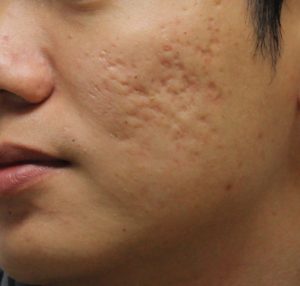Here at Lea Advanced Skincare, we treat all different types of skin concerns. A current popular skin concern among our patients is discoloration. We’ve had a lot of questions about the differences between scars, Melasma, and different discolorations so in this week’s blog we decided to address them and educate our readers! Many patients are confusing scaring with discoloration and discoloration with Melasma. Although these concerns are treated almost similarly there are some minor precautions that determine the differences between the three and need to be taken seriously to reduce the appearance of them on the skin.
 A scar forms when there is an imbalance between the production of collagen and the deconstruction of collagen after a skin injury has not been taken care of properly. A scar is usually risen, bumpy, and discolored. Sometimes scars can be itchy, and form into a keloid (over production of skin cells), or an indent (destruction of collagen interfering with the production of skin cells). A scar can be hyper pigmented, or hypo pigmented. When a scar is hyper pigmented then it can be treated! A serious of Microdermabrasion facials to resurface and retexture the scar is what we recommend. Followed by a properly executed chemical peel. If the chemical peel is done incorrectly it can cause more pigmentation problems, and ruin the integrity of the skin. Unfortunately, a scar is close to permanent. But with the proper treatments, paired with strategic at home care, the appearance of the scar can be drastically minimized. We hate to break it to you but, older scars that have been around for years are vitally impenetrable. The memory in the skin is set in the scar modality, making them none reversible. So if there is scaring that is fairly fresh, and you are below the age 25, they are easier to work with.
A scar forms when there is an imbalance between the production of collagen and the deconstruction of collagen after a skin injury has not been taken care of properly. A scar is usually risen, bumpy, and discolored. Sometimes scars can be itchy, and form into a keloid (over production of skin cells), or an indent (destruction of collagen interfering with the production of skin cells). A scar can be hyper pigmented, or hypo pigmented. When a scar is hyper pigmented then it can be treated! A serious of Microdermabrasion facials to resurface and retexture the scar is what we recommend. Followed by a properly executed chemical peel. If the chemical peel is done incorrectly it can cause more pigmentation problems, and ruin the integrity of the skin. Unfortunately, a scar is close to permanent. But with the proper treatments, paired with strategic at home care, the appearance of the scar can be drastically minimized. We hate to break it to you but, older scars that have been around for years are vitally impenetrable. The memory in the skin is set in the scar modality, making them none reversible. So if there is scaring that is fairly fresh, and you are below the age 25, they are easier to work with.
Discoloration can be from a whole list of things, and can even range in color. Hyperpigmentation is the natural response skin has after inflammation; a vast amount of melanin is produced to protect the area during the healing process. Most commonly discoloration happens after an acne breakout. Often times we see discoloration on the upper lip or below the brow from strip wax causing a minor burn. Discoloration is much easier to treat than a scar, and after a series of treatments discoloration can be close to gone. We have a variety of skincare treatments and at home products that help treat discoloration. An important thing to know about discoloration is that it is more common in different skin types. Mostly women and men who range from an olive to medium brown-olive skin, pigment easier than those with fair skin. Either way, discoloration can be treated, and we at Lea Advanced Skincare have the proper skincare treatments to do so.
 Lastly, Melasma is a type of discoloration that develops mainly from internal factors. For example pregnancy, birth control, and other hormonal shifts can cause Melasma. Melasma can even be triggered from severe stress. This form of discoloration is found mainly in women, although men can get it too. It is rarely caused by the sun, but UV rays can trigger it as well. Melasma is mainly found on the cheeks, forehead, bridge of the nose, or the chin. Melasma can be treated, but the appearance of the pigmentation will only be slightly reduced. It is hard to treat Melasma, if the treatment is too stimulating, it can trigger a deeper pigmentation to form. Like a scar or a discoloration, skin with Melasma should undergo a series of Microdermabrasion facials to help the penetration of your lightening ingredients, helping the reduction of the pigmentation. It is important that if you have Melasma and you are interested in receiving a chemical peel, it is mild and executed properly, or the Melasma will become over stimulated and have a darker pigment.
Lastly, Melasma is a type of discoloration that develops mainly from internal factors. For example pregnancy, birth control, and other hormonal shifts can cause Melasma. Melasma can even be triggered from severe stress. This form of discoloration is found mainly in women, although men can get it too. It is rarely caused by the sun, but UV rays can trigger it as well. Melasma is mainly found on the cheeks, forehead, bridge of the nose, or the chin. Melasma can be treated, but the appearance of the pigmentation will only be slightly reduced. It is hard to treat Melasma, if the treatment is too stimulating, it can trigger a deeper pigmentation to form. Like a scar or a discoloration, skin with Melasma should undergo a series of Microdermabrasion facials to help the penetration of your lightening ingredients, helping the reduction of the pigmentation. It is important that if you have Melasma and you are interested in receiving a chemical peel, it is mild and executed properly, or the Melasma will become over stimulated and have a darker pigment.
Leave a Comment
You must be logged in to post a comment.


